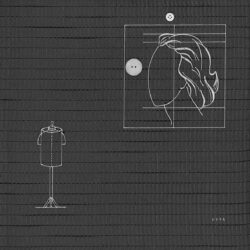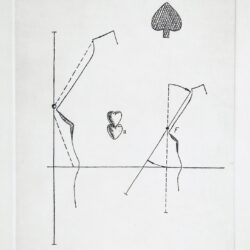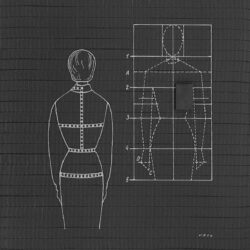While, upon completing his studies, Ottó Vincze began his career as a painter, today, his art is mainly centred on creating spatial installations that can be interpreted within the field of neo-conceptual art. He also has significant works in the genres of graphic and video art.
His works, which possess a critical tone and connect to current contemporary discourse, form a complex aesthetic-visual-philosophical system. He thinks in terms of a complex aesthetic-visual system, with ties not only to Mondrianian and Malevichian human-based constructive-surrealist painting, but also to Szentendre’s Vajda-Korniss-style, “motif-centred” spiritual traditions and to Italian metaphysical painting.
The current exhibition incorporates visual elements of the artist’s maternal heritage, which he rediscovered in the ‘90s: the tools of sewing/tailoring, sewing patterns and exciting figures and illustrations from textbooks, as well as the elegantly simple figures of fashion drawings, presented in absurd, puzzling scenarios.
His picture objects of graphic quality, using old, structured, spatially patterned textiles as support, show human relationships, dilemmas, complex concepts and philosophical content. His emptied out backgrounds are populated by uniformised, frozen, puppet-like figures and anthropomorphic, shell-like sewing patterns, while, as a form of situational practice, they
confront the fragility of social expectations with the emotional life of human beings. The titles of the works aid viewers in navigating the intellectual labyrinths of the images, reminiscent of both airy drawings and pictograms.
The displayed object ensemble – which occupies the first exhibition room, and which responds to the challenges of spatiality while also adhering to the aforementioned strict aesthetic system – is an extension of image-based installations. In this spatial construction, the lean, reduced forms of the “image objects”, the geometric precision of the figures, the monotonous rhythm and magical metaphysics of textile patterns also return, but, in the use of the velvety, deep-black material, a new sensual quality also appears.
In this way, his ensembles of environments and graphic art present Vincze as a peculiar collector, who surrounds himself with relics and mysterious objects, while also taking pleasure in devising enigmatic figures and surprising constructions.
Brigitta Muladi


